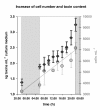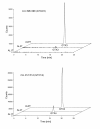Comparative gene expression in toxic versus non-toxic strains of the marine dinoflagellate Alexandrium minutum
- PMID: 20403159
- PMCID: PMC2874808
- DOI: 10.1186/1471-2164-11-248
Comparative gene expression in toxic versus non-toxic strains of the marine dinoflagellate Alexandrium minutum
Abstract
Background: The dinoflagellate Alexandrium minutum typically produces paralytic shellfish poisoning (PSP) toxins, which are known only from cyanobacteria and dinoflagellates. While a PSP toxin gene cluster has recently been characterized in cyanobacteria, the genetic background of PSP toxin production in dinoflagellates remains elusive.
Results: We constructed and analysed an expressed sequence tag (EST) library of A. minutum, which contained 15,703 read sequences yielding a total of 4,320 unique expressed clusters. Of these clusters, 72% combined the forward-and reverse reads of at least one bacterial clone. This sequence resource was then used to construct an oligonucleotide microarray. We analysed the expression of all clusters in three different strains. While the cyanobacterial PSP toxin genes were not found among the A. minutum sequences, 192 genes were differentially expressed between toxic and non-toxic strains.
Conclusions: Based on this study and on the lack of identified PSP synthesis genes in the two existent Alexandrium tamarense EST libraries, we propose that the PSP toxin genes in dinoflagellates might be more different from their cyanobacterial counterparts than would be expected in the case of a recent gene transfer. As a starting point to identify possible PSP toxin-associated genes in dinoflagellates without relying on a priori sequence information, the sequences only present in mRNA pools of the toxic strain can be seen as putative candidates involved in toxin synthesis and regulation, or acclimation to intracellular PSP toxins.
Figures




Similar articles
-
Genetic association of toxin production in the dinoflagellate Alexandrium minutum.Microb Genom. 2022 Nov;8(11):mgen000879. doi: 10.1099/mgen.0.000879. Microb Genom. 2022. PMID: 36326655 Free PMC article.
-
First determination of extracellular paralytic shellfish poisoning toxins in the culture medium of toxigenic dinoflagellates by HILIC-HRMS.Ecotoxicol Environ Saf. 2020 Nov;204:111042. doi: 10.1016/j.ecoenv.2020.111042. Epub 2020 Jul 29. Ecotoxicol Environ Saf. 2020. PMID: 32738626
-
Evaluation of the production of paralytic shellfish poisoning toxins by extracellular bacteria isolated from the toxic dinoflagellate Alexandrium minutum.Can J Microbiol. 2009 Aug;55(8):943-54. doi: 10.1139/w09-047. Can J Microbiol. 2009. PMID: 19898534
-
Paralytic shellfish toxin biosynthesis in cyanobacteria and dinoflagellates: A molecular overview.J Proteomics. 2016 Mar 1;135:132-140. doi: 10.1016/j.jprot.2015.08.008. Epub 2015 Aug 25. J Proteomics. 2016. PMID: 26316331 Review.
-
Environmental Factors Modulate Saxitoxins (STXs) Production in Toxic Dinoflagellate Alexandrium: An Updated Review of STXs and Synthesis Gene Aspects.Toxins (Basel). 2024 Apr 30;16(5):210. doi: 10.3390/toxins16050210. Toxins (Basel). 2024. PMID: 38787062 Free PMC article. Review.
Cited by
-
Evolution and distribution of saxitoxin biosynthesis in dinoflagellates.Mar Drugs. 2013 Aug 8;11(8):2814-28. doi: 10.3390/md11082814. Mar Drugs. 2013. PMID: 23966031 Free PMC article. Review.
-
Differentiating Two Closely Related Alexandrium Species Using Comparative Quantitative Proteomics.Toxins (Basel). 2020 Dec 23;13(1):7. doi: 10.3390/toxins13010007. Toxins (Basel). 2020. PMID: 33374829 Free PMC article.
-
Molecular Identification and Toxin Analysis of Alexandrium spp. in the Beibu Gulf: First Report of Toxic A. tamiyavanichii in Chinese Coastal Waters.Toxins (Basel). 2021 Feb 18;13(2):161. doi: 10.3390/toxins13020161. Toxins (Basel). 2021. PMID: 33670744 Free PMC article.
-
Progress in understanding harmful algal blooms: paradigm shifts and new technologies for research, monitoring, and management.Ann Rev Mar Sci. 2012;4:143-76. doi: 10.1146/annurev-marine-120308-081121. Ann Rev Mar Sci. 2012. PMID: 22457972 Free PMC article. Review.
-
Omics Analysis for Dinoflagellates Biology Research.Microorganisms. 2019 Aug 23;7(9):288. doi: 10.3390/microorganisms7090288. Microorganisms. 2019. PMID: 31450827 Free PMC article. Review.
References
-
- Lilly EL, Halanych KM, Anderson DM. Phylogeny, biogeography, and species boundaries within the Alexandrium minutum group. Harmful Algae. 2005;4:1004–1020. doi: 10.1016/j.hal.2005.02.001. - DOI
-
- Geraci JR, Anderson DM, Timperi RJ, Staubin DJ, Early GA, Prescott JH, Mayo CA. Humpback whales (Megaptera novaeangliae) fatally poisoned by dinoflagellate toxin. Canadian Journal of Fisheries and Aquatic Sciences. 1989;46:1895–1898. doi: 10.1139/f89-238. - DOI
-
- Trainer VL, Baden DG. High affinity binding of red tide neurotoxins to marine mammal brain. Aquatic Toxicology. 1999;46:139–148. doi: 10.1016/S0166-445X(98)00125-8. - DOI
-
- Sako Y, Yoshida T, Uchida A, Arakawa O, Noguchi T, Ishida Y. Purification and characterization of a sulfotransferase specific to N-21 of saxitoxin and gonyautoxin 2+3 from the toxic dinoflagellate Gymnodinium catenatum (Dinophyceae) Journal of Phycology. 2001;37:1044–1051. doi: 10.1046/j.1529-8817.2001.00119.x. - DOI
Publication types
MeSH terms
Substances
LinkOut - more resources
Full Text Sources
Other Literature Sources
Molecular Biology Databases
Research Materials
Miscellaneous

